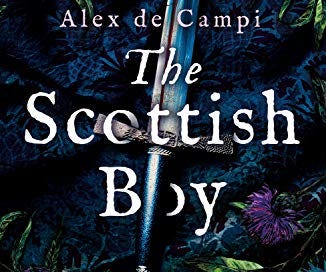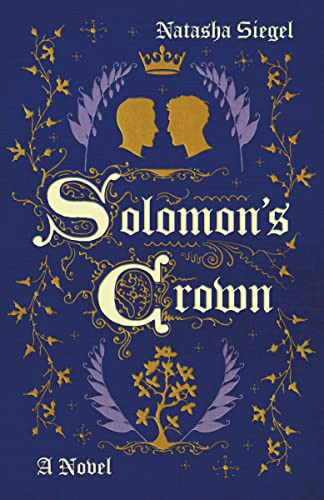Queer Historical Fiction and the Vexing Question of Accuracy
Recent queer historical novels ask us to think differently about how we relate to the past and how it is represented in fiction.
This is proving to be a very good time indeed for queer historical fiction, and I’ve recently devoured two very good books, Natasha Siegel’s Solomon’s Crown and Alex de Campi’s The Scottish Boy. These two novels actually make for an interesting pairing. They both take place in the medieval period (Solomon’s Crown during the life of Richard I and Philip II of France, The Scottish Boy during the reign of Edward III and ); they both feature gay romance; and they both have a very, shall we say flexible, attitude toward historical accuracy.
Siegel is very upfront about this in her forward to her book, arguing (compellingly, I think) that, since the real story of Richard and Philip ended in tragedy, with the two men constantly waging war against one another, she wanted to write a romance instead, with the joy such a generic label connotes. Indeed, the book takes some significant liberties with the known facts of history, inventing various battles and ignoring others. In essence, the only thing about the book that can be said to be strictly accurate are the presence of various characters–Richard, Philip, Eleanor of Aquitaine, John, Henry II, Geoffrey, etc.--and their relations between its characters.
The Scottish Boy likewise takes some notable liberties with its story. In addition to creating a more tolerant ethos than was likely in the Middle Ages–the erotic relationship between its two main characters is largely accepted, either implicitly or explicitly, by almost everyone they encounter–there’s also a certain character whose relationship to the French royal family is entirely fictional. Unlike Siegel, De Campi doesn’t have an author’s note laying out what is true and what isn’t, but it’s not hard to see how The Scottish Boy presents a picture of the Middle Ages that is far more modern in its sensibility than it is medieval.
All of this raises a series of questions regarding the need for historical authenticity in works that take place in a past that is at least fairly well-documented, particularly when such works are framed and marketed as historical fiction. While some amount of license is a key part of this particular genre, most readers, I daresay, expect books in the genre to have at least a measure of fidelity to the real past. In fact, most historical novels have a note at the end from the author, explaining what changes they made and why (very often, the changes to the real history are made for narrative and dramatic reasons, since history rarely follows the same rules as fiction).
What happens, though, when such a note isn’t included? Most obviously, such an omission makes it more difficult for the reader to parse what’s real and what’s not in a given novel. This, in turn, raises significant issues regarding the purpose of the genre as a whole, for while it is not the job of historical fiction to educate (or, at least, that’s not its primary purpose) it’s important to recognize that many people do get their fundamental understanding of the past and its residents through the medium of fiction.
The question of factual fidelity is nothing new when it comes to historical fiction, of course. Any piece of fiction–whether it’s a book, a film, or a TV series–has to tread a fine line when it comes to adhering to the historical facts as these have been established by historians. As a friend of mine pointed out to me, some of the most highly-regarded pieces of historical fiction, on both the page and the screen, take significant liberties with historical fact in their efforts to create something that truly immerses the reader in the past.
Thus, I’ll admit that I was a bit perplexed when I read both Solomon’s Crown and The Scottish Boy. For all that I continue to insist that I am not one of those pedants who likes to nitpick a piece of historical fiction for all of its liberties and changes with historical fact, the truth is that, when it comes to periods about which I know a great deal, I do expect my fiction to have at least some basic adherence to the known facts. Siegel’s forthright admission that she chose not to do so at first turned me off a bit, and it was always in the back of my head as I read Solomon’s Crown. A similar dynamic was at work while I was reading The Scottish Boy, because I quite simply couldn’t believe that the world being shown here was anything other than an idealized and utopianized version of the real Middle Ages.
The more I thought about it, however, the more I came to believe that it is precisely these works’ jettisoning of the trappings of more traditional historical fiction that gives them their queer bite. For far too long, queer people have been written out of history (and historical fiction) and, when they are present, their stories are framed as essentially and inescapably tragic. In the traditional historical imagination, there can be no real happy ending for queer people because both because material conditions made their existence impossible and/or because the past has often been understood to be a queer-phobic space.
When, therefore, authors like Siegel and De Campi create a history as it might have or should have been rather than as it was, they are making a very powerful queer critique not just of historical fiction as a genre but also history itself. Richard and Philip and Harry and Iain each, in their own ways, resist the impositions of a supposedly more homophobic era, embracing the pleasures of the flesh and, more specifically, of sex. In fact, the sex scenes in The Scottish Boy are, if I’m being honest, some of the most arousing I’ve ever read and, rather than being merely provocative or titillating, they are key to the characters, their development, and their love for one another.
It would have been easy for both Siegel and De Campi to just take their characters and put them into a world that was inspired by our own, rather than making any kind of claim to being located in the “real world.” By doing so, these authors have queerly pushed at the boundaries of their chosen genre, asking us to think critically about the role of queer characters, and queerness in general, in stories about the past. Rather than obeying the strictures imposed by a heteronormative tradition, they show us the ways that queerness can provide alternative types of pleasure, ones beyond simple accuracy. In doing so, they also help us to imagine other histories and, just as importantly, other presents, as well.





